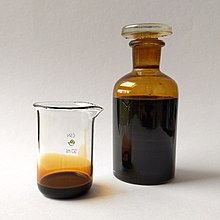

A biogenic substance is a product made by or of life forms. While the term originally was specific to metabolite compounds that had toxic effects on other organisms,[1] it has developed to encompass any constituents, secretions, and metabolites of plants or animals.[2] In context of molecular biology, biogenic substances are referred to as biomolecules. They are generally isolated and measured through the use of chromatography and mass spectrometry techniques.[3][4] Additionally, the transformation and exchange of biogenic substances can by modelled in the environment, particularly their transport in waterways.[5]
The observation and measurement of biogenic substances is notably important in the fields of geology and biochemistry. A large proportion of isoprenoids and fatty acids in geological sediments are derived from plants and chlorophyll, and can be found in samples extending back to the Precambrian.[4] These biogenic substances are capable of withstanding the diagenesis process in sediment, but may also be transformed into other materials.[4] This makes them useful as biomarkers for geologists to verify the age, origin and degradation processes of different rocks.[4]
Biogenic substances have been studied as part of marine biochemistry since the 1960s,[6] which has involved investigating their production, transport, and transformation in the water,[5] and how they may be used in industrial applications.[6] A large fraction of biogenic compounds in the marine environment are produced by micro and macro algae, including cyanobacteria.[6] Due to their antimicrobial properties they are currently the subject of research in both industrial projects, such as for anti-fouling paints,[1] or in medicine.[6]
- ^ a b Cite error: The named reference
Bhadury_2004was invoked but never defined (see the help page). - ^ Francis R, Kumar DS (2016). Biomedical Applications of Polymeric Materials and Composites. John Wiley & Sons.
- ^ Cite error: The named reference
Lukman_2014was invoked but never defined (see the help page). - ^ a b c d Cite error: The named reference
Albrecht_1971was invoked but never defined (see the help page). - ^ a b Cite error: The named reference
Leonov_2011was invoked but never defined (see the help page). - ^ a b c d Cite error: The named reference
Burja_2001was invoked but never defined (see the help page).